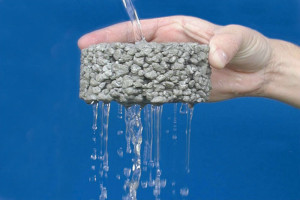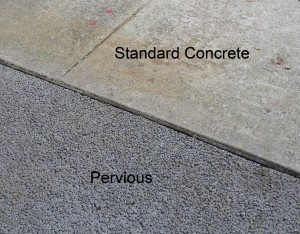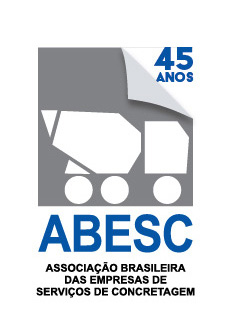“They paved paradise, and put up a parking lot.” Joni Mitchell
Joni Mitchell’s lyric lamenting that “they paved paradise and put up a parking lot” is ringing true as cities become even more urban, with more roads, sidewalks, and car parks. All those impervious surfaces create a host of problems, such as an increasing the urban heat island effect, preventing the natural recharge of groundwater supplies, and polluting waterways.
A different type of concrete, pervious concrete, can solve those problems at little to no additional cost, and with relatively little additional training and equipment changes.
Pervious concrete is normal concrete without the addition of fine aggregates such as sand. In typical concrete mixes, sand and other fines make up a proportion of the mix, which can vary depending on the qualities needed. Forgoing the fine aggregates results in a porous mix with a void content of 15 to 20 per cent.
Typically used for low-speed and/or low-volume applications such as car parks, sidewalks, and secondary roads, pervious concrete can be engineered to deliver comparable performance to traditional concrete.
According to the National Ready Mixed Concrete Association, typical pervious concrete mixes achieve a compressive strength of 3.5 to 28 MPa, which is suitable for a wide range of applications. Typical values are about 17 MPa. Standard concrete mixes achieve 10 to 40 MPa.
Flow rates through pervious concrete, according to the NRMCA, can vary greatly depending on the materials selected and placing operations, with 120 to 320 L/m²/min being typical. In a real-world scenario, that flow rate means five-inch thick pavement with 20 per cent voids will be capable of storing one inch of rain in its voids. That is enough to cover most rainfalls in the US. When poured onto six inches of open-grade gravel or crushed rock, the pervious concrete can store up to three inches of water.
Pervious concrete offers a host of environmental benefits, including first flush pollution control and stormwater management. The material is listed as a Best Management Practice by the US Environmental Protection Agency. Pervious concrete traps some of the pollutants contained in the first flush of stormwater after rainfall, such as oil, gas, and antifreeze, keeping them out of the waterways. Naturally occurring bacteria and fungi then biodegrade 97.6 to 99 per cent of hydrocarbons, according to the EPA.
As mentioned previously, pervious concrete lets water drain directly through the pavement, which lessens the amount of runoff from surfaces, decreasing the need for detention areas and allowing for smaller storm sewers. That allows for more land to be devoted to productive or profitable uses. Pervious concrete also lets water percolate into the soil, recharging groundwater, and supporting trees on-site, which often struggle when placed in paved areas.
Trees, of course, help to lessen the urban heat island effect on their own, and pervious concrete does, as well. Compared to asphalt, pervious concrete’s lighter color and more open structure absorb and hold less heat.
The US Green Building Council’s LEED rating tool has recognized pervious concrete, with points available for Sustainable Sites, Water Efficiency, Materials and Resources, and Innovation in Design.
Proponents claim that the material is more durable than asphalt.
“Parking areas properly designed and constructed will last 20-40 years with little or no maintenance,” says the National Ready Mixed Concrete Association (NRMCA). “Unlike asphalt, surface raveling (the loosening of surface aggregates) is common only in the first few weeks after the concrete is laid, and it can be reduced with proper compaction and curing techniques.”
In the US, most pervious concrete has been installed in the southern states. Concerns over performance in cold areas, and particularly over freeze-thaw resistance, have limited pervious concrete’s use in cold areas. However, the material has been thoroughly tested, according to industry sources.
“There have been several pervious concrete pavement projects in dry and wet freeze areas demonstrating good field performance over several years,” says the The Portland Cement Association.
Projects in North Carolina and Tennessee have shown good performance for more than 10 years.
Testing at Villanova University starting in 2002 showed researchers the performance characteristics of pervious concrete in colder areas. Their test sites showed substantial deterioration within one to two years, which they blamed on site conditions at the time of installation and the low water content of the mix. They noted that the mix is highly sensitive to air temperature and base moisture.
In some cold-weather circumstances, pervious concrete can perform better than asphalt paving. In freeze-thaw conditions, pervious concrete eliminates standing water, alleviating the safety hazard of refreezing on surfaces such as asphalt.
In Australia, researchers at the University of Southern Queensland tested permeable concrete and published this paper on the subject. They concluded that pervious concrete has the potential for wider use in Australia, and noted the importance of specific mix design, proper selection of aggregates, and the need for additives to increase bonding strength. By managing those factors, they said, “permeable concrete pavement of compressive strength up to 30 MPa with acceptable permeability can be obtained.”
Cost should not be significantly different from standard concrete. Compared to asphalt, pervious concrete will be higher initially, but should last substantially longer. The NRMCA claims that “concrete saves money in the long run due to its superior durability and strength. It requires fewer repairs than asphalt, and has a longer overall lifespan as well.”
Some areas may need cleaning or vacuuming periodically, but proper design is the most essential step to minimize soil and sand from flowing onto the surface, which could reduce the permeability of the concrete.
Contributor: Steve Hansen
Fonte: www.sourceable.net








